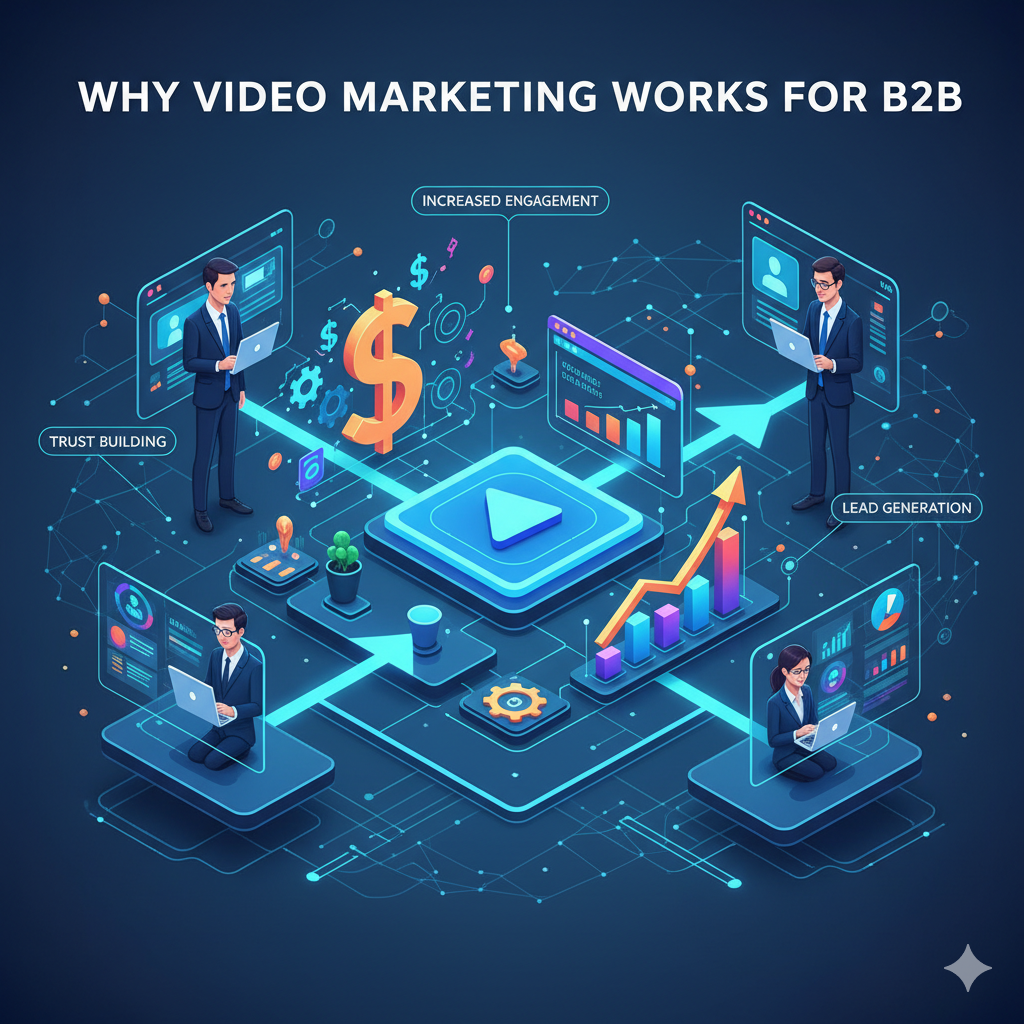The Power of Video Marketing for B2B

In today’s digital-first world, attention has become one of the scarcest resources. For B2B brands competing in crowded markets, breaking through the noise and connecting with decision-makers isn’t easy. Traditional content formats, from lengthy PDFs to static posts, often fall short in capturing real engagement.
That’s where video marketing changes everything.
Video has become one of the most effective tools for B2B marketers to educate, influence, and convert audiences. It brings complex ideas to life, simplifies communication, and builds trust, all within a few seconds of viewing. More than a visual asset, video is now a strategic driver of engagement, sales, and customer relationships.
At Growthmak, we believe the future of B2B marketing is visual, interactive, and human, and video is the medium that delivers all three.
Why Video Marketing Works for B2B

Video marketing to business buyers involves using video content to attract, inform and persuade buyers. It does not focus on product demonstrations. Video makes complicated concepts easy to understand and clearly communicates your solutions to you in a manner that is easy to comprehend.
The modern B2B environment requires trust. Video content marketing in B2B makes that possible. It makes your brand come alive, demonstrates your experience and makes technical information more approachable. Buyers are able to view the faces behind the brand, and not the product only.
Action is also promoted by video. A properly developed video content plan can lead the prospects to download the content, request demos, or buy products. It is a tested method of assisting in reaching every delivery phase of the buyer journey. Above all, video provides quantifiable outcomes. Video campaigns in B2B can be used to stimulate actual interaction, enhance the quality of leads, and facilitate sales conversion. Video is no longer a complete part of modern B2B content marketing. An AI video editor can be used to simplify the process of creating the video.
According to recent industry insights, around 70% of B2B buyers engage with video content during their purchasing journey, using it to evaluate vendors, understand use cases, and make confident decisions. This shows that video is no longer a “nice-to-have”; it’s a core driver of buyer trust and conversion.
Pro Tip: The right video doesn’t just inform, it inspires. Use storytelling to connect emotionally while keeping information precise and actionable.
Who Benefits from B2B Video Content
B2B video content is powerful because it attracts all the stakeholders involved in the purchasing process, and in many cases, written content cannot.
1. The clear and concise explainer videos that can be broken down to simplify complex features and integrations can be beneficial to technical buyers, including IT leaders, solution architects and product managers. These videos can assist them in testing technical compatibility, and they know how your solution fits into their existing infrastructure.
2. Finance leaders and procurement professionals are economic buyers who are concerned with cost-effectiveness and return on investment. Videos on ROI, pricing summary and success stories of customers give them the financial justification they need to make investment decisions.
3. Strategic alignment interests the business decision-maker most, which may be a department head, an operations leader, or a CXO. The credibility of your organisation and overall business value of your solution can be shown by thought leadership content, industry insights and real-life case studies.
In addition to the buying committee, internal teams are also interested in the properly implemented B2B video marketing strategy:
Personalised videos enable sales teams to establish better relationships. Subsequently, streamline the complicated value propositions and facilitate proposal discussions.
Video helps marketing teams to enhance the engagement of campaigns, educate audiences, and advance leads through the funnel.
Videos in customer success teams are used in onboarding, training, and retention programs, and these programs help customers to gain value during their experience.
An effective strategy for B2B video content marketing guarantees that every stakeholder is provided with the appropriate content that is impactful and at the appropriate time.
The Strategic Benefits of B2B Video Marketing
For the best results, consider video marketing over single video campaigns. Video is the most powerful when it is tied to every touchpoint of your buyer’s journey. Here’s where your B2B video content can be advantageous.
1. Builds Immediate Trust and Credibility
Trust is the foundation of every B2B deal. Videos like testimonials, behind-the-scenes footage, and expert interviews show the human side of your company. They prove that your brand delivers real value, not just promises.
2. Simplifies Complex Solutions
For industries like SaaS, finance, or manufacturing, it’s often difficult to explain value in a few words. Explainer videos and product demos break down complex ideas into short, digestible narratives that anyone can understand.
3. Drives Higher Engagement and Retention
Viewers retain up to 95% of a message when it’s delivered through video, compared to just 10% when reading text. Videos capture attention faster, and people are far more likely to remember what they saw and heard.
4. Enhances Conversions Across Channels
Adding a video to your website or email can dramatically boost performance. In fact, studies show that emails with embedded video experience 2–3x higher click-through rates. It’s the difference between being noticed and being ignored.
5. Accelerates Revenue Growth
Data proves that companies using video in their marketing strategy experience 49% faster revenue growth compared to those that don’t. It’s clear that when storytelling and strategy meet, results follow.
Where to Use Video in Your B2B Marketing Funnel

Video is most powerful when it’s integrated across every touchpoint in your buyer journey, from awareness to retention.
1. Awareness Stage: Capturing Attention
- Brand Films & Intro Videos: Showcase your mission, values, and vision.
- Social Snippets: Short, energetic videos for LinkedIn or Instagram that highlight expertise or culture.
- Thought Leadership Clips: Position your brand as a trusted authority with quick insights or commentary on industry trends.
2. Consideration Stage: Educating and Persuading
- Product Explainers: Demonstrate what makes your solution unique and how it solves real business challenges.
- Customer Case Studies: Share success stories that show results in action.
- Webinar Highlights: Repurpose key insights into short videos to nurture prospects further.
3. Decision Stage: Building Confidence
- Live or Recorded Demos: Give prospects a close look at your product’s capabilities.
- ROI Videos: Clearly illustrate value and cost-effectiveness.
- Personalised Sales Videos: Create short clips addressing specific client needs or questions , adding a personal touch that written emails can’t replicate.
4. Post-Sale Stage: Retaining and Advocating
- Onboarding Tutorials: Help customers use your product efficiently.
- Feature Walkthroughs: Introduce new updates or integrations.
- Customer Advocacy Stories: Transform happy clients into ambassadors who champion your brand.
How to Create a B2B Video Strategy That Converts
The development of a scalable performance-based B2B video marketing production process does not need to be complex, but it must be planned and consistent:
1. Mapping Your Audience and Buyer Journey.
Know your perfect customers, their problems, and the major questions that the customers pose at every level. The video content that you produce must conform to their decision-making process.
2. Place a High Priority on High-Impact Videos.
When you are new, prioritise the most valuable formats, which are product explainers, case studies, demo videos, and customer success stories.
3. Repurpose Existing Content
Blogs, webinars, and presentations are great content to maximise your content ROI by converting them into social, email, and sales enablement video bite-sized content.
4. Leverage Tools & Partners
Video does not need to work your internal resources. Video agencies can work with special tools, such as Vidyard, Loom, or Biteable, or collaborate with them to be faster.
5. Measure What Matters
Measures such as engagement rates, play rates, lead quality and conversion do not only impact views. Constant improvement is the main step to success in the long term.
Making Video a Core Growth Engine
Video isn’t just another marketing tool; it’s a bridge between brand and buyer. It builds credibility, simplifies decision-making, and sparks emotional connections, something data sheets alone can’t do.
For Growthmak and our clients, the introduction of well-planned video campaigns has helped shorten sales cycles, improve lead quality, and strengthen brand recall. Whether it’s through educational reels, animated explainers, or AI-driven personalised outreach, video has proven to be a consistent performer across the funnel.
Pro Tip: Repurpose existing content. A single webinar can generate multiple short-form clips for social media, product explainers, and email campaigns, maximising ROI with minimal effort.
Conclusion
The era of passive B2B marketing is over. Today’s buyers expect clarity, credibility, and connection, and video delivers all three. It transforms complex stories into memorable experiences, engages stakeholders across levels, and drives measurable growth.
If you haven’t yet invested in a B2B video strategy, now is the time. Start small, focus on consistency, and build momentum with data-driven insights. Each video you produce is an opportunity to strengthen your brand’s voice and convert interest into trust.
Get Started with Growthmak Today!
Unlock your marketing potential with our expert team.





.svg)

